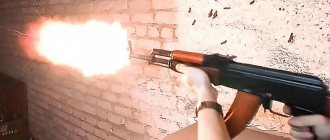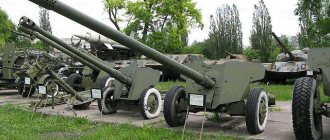Brass knuckles are a bladed weapon worn on the fingers and used in fist fights. Many people have the impression that only bandits and hooligans use it, but it turns out that the history of brass knuckles goes back more than one millennium. Who first invented it, how did it change its appearance and what varieties are there now?
A brass knuckle is a metal object with holes for the fingers. Sometimes the structure is “reinforced” with special sharp tips in order to “reward” the enemy with stab wounds in addition to a painful blow.
The word "brass knuckles" comes from the French "casse-tete", which means "breaks one's head." A very appropriate name!
The history of brass knuckles, according to historians, began at the very beginning of our era. Gladiators used them during their fights, and then there were two types of brass knuckles. The first was called the “bronze fist” and was a bronze plate with slots, clamped in the fist.
Cestus
The second type was called “cestus” and consisted of thin leather belts that were wrapped around the hands and wrists - these were a kind of protective gloves for the hands. So that, in addition to their protection, they could bring more harm to the opponent, cestus were reinforced with lead liners, staples or spikes.
Years passed, and brass knuckles began its triumphal march around the world. In different countries and at different times it was made from metal, wood, horn, and even shark teeth.
In the Middle Ages, the popularity of brass knuckles waned, as armor and combat gloves were in use. Brass knuckles, so to speak, were revived by Italian sailors of the fifteenth century, who often engaged in boarding battles with other ships. They fought with blades, but in conditions of close contact it was more convenient to hit the enemy not with the tip, but with the hilt, therefore, for greater efficiency, the hilt was reinforced with brass knuckles.
Knife-brass knuckles
Many people liked this idea, and the combination of brass knuckles and cutting weapons began to be used by many peoples.
In Eastern countries, combat combs, which are brass knuckles with long “claws,” have become popular.
Comb-brass knuckles
Brass knuckles became widespread throughout the world in the 19th century; they were carried by beggars, criminals, and noble gentlemen. True, if every rabble made brass knuckles themselves, then rich people had brass knuckles made of precious metals, made by famous craftsmen.
Brass knuckles ring
By the 20th century, brass knuckle manufacturers began to get original, trying to get ahead of their competitors. At the same time, very strange types of these weapons were sometimes produced. For example, a model of brass knuckles was once released, which was a massive ring with a 1.7 mm caliber revolver mounted in it. Everything would be fine, but a shot from such a revolver was absolutely harmless to the attacker. He could only kill an insect or a mouse.
During these years, inscriptions on brass knuckles came into fashion, something like “my most faithful friend.”
By the middle of the last century, the market was fed up with brass knuckles, and prices for them fell sharply. Moreover, the need for them disappeared, since for affordable money it was possible to purchase firearms that were much more “lethal.”
Nowadays brass knuckles are an attribute of bandits or those who want to show off.
You can find some very interesting things with brass knuckles on sale.
Brass knuckles bag
Bag-brass knuckles
And here is a small elegant lady's handbag, the handle of which is made in the form of brass knuckles and decorated with rings. According to the manufacturer, this model will completely help a weak lady protect herself.
Jewelers also offer brass knuckles jewelry to beauties. Both beautiful and painful. Just like on the handbag, it represents several rings connected into a single whole. Made of precious metals and decorated with stones. An elegant little thing that you can show off and punch the offender if the need arises to stand up for yourself.
Knives
This is a completely separate topic. And don’t rely on a certificate stating that your knife is not a bladed weapon. Do not think that you will be able to learn the criteria by which a knife will be considered a bladed weapon, and clearly justify to the police that you have a household knife in your belt. Better yet, think about this first: can you really use this knife? Are you ready for the fact that its use will be considered by the court as an excess of necessary defense measures in 99.9% of cases?
Cutting templates
Making a craft using a ready-made template is much easier - you don’t need to waste time creating your own sketch, you just need to print one of the options you like and start assembling.
An exciting activity, assembling a brass knuckles from paper with your own hands is perfect for filling your leisure time. The finished craft, which is strong and durable, will allow it to be used in “war” games, reconstructions of events, or theatrical productions.
Solid
This type of jewelry looks like one large ring, elongated into an oval shape. It is suitable only for special occasions: wearing such a product regularly is not very convenient. Due to the lack of locking mechanisms, the solid ring is more easily damaged or lost than usual.
Decoration necessarily requires precise preliminary fitting. You won't be able to buy it as a gift for a loved one - the probability of making a mistake with the size is too high. This model is not suitable for those who are prone to swelling in the heat: in the warm season it can compress the skin, and in the cold it can subside.
Brass knuckles are a percussion-piercing-cutting weapon in the form of thick welded metal rings or a metal plate with slots for fingers, worn on the hand to enhance the blow; spikes and protrusions are used as additional elements.
A brass knuckle grip weapon is a type of brass knuckle, consisting of a handle and a warhead in the form of blades, spikes or a point, and the warhead is like a continuation of the fist. Adapted household items and tools can be used as brass knuckle grip weapons.
European type brass knuckles
The ancient French brass knuckles (by the way, the term “cassetete” literally translates as “break your head” or “puzzle”) has been successfully used not only by street fighters, but also by regular army soldiers for hundreds of years.
Francois Rabelais (1494–1553) wrote about the use of brass knuckles in minor brawls:
“...Here are new iron gloves covered with suede. Put them on and beat the villain without mercy. “When it came to the fists, the teller was beaten in a way he had never dreamed of... Messire Udar covered his iron glove with the end of his robe and drummed it on the teller so hard that he broke eight of his ribs...”
Ordinary brass knuckles. According to the hairdryer, brass knuckles are called “supply”, “seasoning” or “handle”. The classic type of brass knuckles has survived to this day practically unchanged from antiquity. A typical example of a brass knuckle is four linearly welded rings, or a solid plate with one large or four small holes for the fingers. On the striking part there are spikes or protrusions (corresponding to the knuckles).
Various brass knuckle options
A T-shaped variation of the classic brass knuckles is often found - a T-shaped protrusion extends from four linear rings to rest on the palm.
There is also a type of brass knuckles in the form of a thick metal rod, curved like the flattened Greek letter “omega”.
Non-metallic brass knuckles usually have the shape of a trapezoid or parallelogram with an oval hole for the fingers inside this “shape”.
Brass knuckles made of a thick metal rod
Regular brass knuckles are made from various metal alloys, brass, lead, copper, as well as from plexiglass, textolite, plexiglass, and hard wood. The thickness of the brass knuckles is 1–3 cm. The length, diameter of the rings and other dimensions are selected individually, and it is necessary that its part opposite the combat one be sufficiently “deep” and rest securely in the palm with a clenched fist (otherwise the fighter risks the first blow break your fingers with your weapon).
Different types of brass knuckles
There is no special technique for using brass knuckles. The brass knuckles are a kind of shock extension and weighting of the hand clenched into a fist. Accordingly, with a fist and brass knuckles, direct and side blows are applied to the enemy’s head and body. With known dexterity, you can try to parry a bladed weapon with brass knuckles. A blow with brass knuckles leads to severe injuries - bone fractures, crushing of soft tissues, rupture of blood vessels, extensive interstitial hemorrhages, concussions and ruptures of internal organs are also possible.
A “real” brass knuckle is definitely an illegal weapon, and it’s not that easy to make. That is why various devices such as brass knuckles are very popular on the streets.
"CHAMOMILE". A fire hydrant valve of the “daisy” type is perhaps the most popular weapon among certain groups of teenagers.
Adapted brass knuckles type "daisy"
BRASS KNIFE. Such combined weapons appeared during the First World War in the armies of a number of countries (USA, UK, France, etc.). Currently, in the criminal environment, handicraft samples of two types are sometimes found:
a) a knife (less often a dagger), the handle of which is covered by a kind of “arc”, turned into brass knuckles (equipped with cutouts for fingers, spikes, striking elements, etc.);
b) a solid plate-brass knuckles to which a small blade is attached.
Handicraft knives
Fist weights
The ancestor of brass knuckles can be considered a fist weight, clamped inside it. The most ancient weighting material is ordinary stone.
PIG. It is a piece of metal that is cylindrical, oval or spindle-shaped. The lead (stock “stock”, or “shtof”) may have recesses for the fingers, and may protrude slightly from the fist on one side, ending in a spherical thickening. The pig is held with this thickening downward in order to strike them on the head. Leads of a different type are also known, equipped with sharp protrusions. In one embodiment, such projections are located at both ends of the lead. In another, a sharp protrusion is located on the side of a piece of metal and is pinched between the fingers. This is already something between the lead and the eastern type of brass knuckles. The diameter of the lead is usually 1–5 cm, the total length is from 8 to 15 cm.
It should be noted that the manufacture, wearing and use of the lead itself is associated with a number of difficulties. Therefore, various adapted weights are often used on the streets: a metal lighter, batteries (such as a Krona battery), massive lock keys, medium-sized wrenches, and even matchboxes filled with sand. Of course, the effectiveness of such improvised weapons is much lower than that of a real gun. However, sometimes even a handy weight can provide a certain advantage in a fight.
Various types of pigs
Eastern type brass knuckles
From a European point of view, oriental brass knuckles are something between a weight and a regular brass knuckle. In this regard, mention should be made of yawara, kubotan and tekko.
YAVARA is a wooden or metal round rod with a length of 12 to 18 cm and a diameter of 1.5–3 cm. It is clamped in a fist so that the ends of the rod protrude from it up and down by no less than 1 cm and no more, than 4 cm. The ends of the rod themselves can be flat, cut at an angle or pointed, or have thickenings.
Various types of yawara
Generally speaking, the javara can be held in different ways, but usually it is held by the middle. This grip strengthens the punch like a lead fist and makes it “correct,” which is very important for those who have not practiced boxing or karate. With the ends of the rod protruding from the fist, it is convenient to perform piercing, poking and cutting (more precisely, scratching) blows in all directions. The main targets are the opponent's hands, forearms, elbows and shoulders, as well as the head, neck and stomach.
KUBOTAN is a modern variety of yawara, disguised as a keychain, and the ends of the stick-handle are most often rounded. The total length is 10–15 cm, diameter is 1–2 cm. Unlike the yawara, such a “keychain” is an absolutely legal weapon. However, its use requires dexterity and special training. With a keychain stick, targeted blows are applied to painful areas of the enemy’s body; it is also possible to parry a blow from an arm or leg.
Wooden kubotan (top) and metal (bottom). Ways to hold a kubotan
The technique of using yawara and kubotan includes direct and side punches; striking and parrying the enemy's limbs with the side surfaces of the fist, reinforced with the pointed or blunt ends of the stick-handle: targeted blows to painful points; scratching movements.
Additionally, the massive keychain is a "micro-flail" because the flexible joint allows the keys to be hit hard against an opponent's face, arms, and knees.
TEKKO. This is a type of yawara that is closest to brass knuckles. The ends of the tekko are pointed, and 1–3 sharp spikes are attached perpendicular to the body of the stick. A hooligan version of the eastern “tekko”, this is the domestic “three-headed brass knuckles with nails”. It is made from a piece of round wood 11–15 cm long, 3–4.5 cm in diameter, and three or four 7 cm nails. Nails are driven into the wood from three sides to half their length. The result is a weapon of great destructive power (see figure on page 95 below).
Tekko and how to hold it
"CLAWS." A very dangerous, but fortunately rare variety of oriental weapons with brass knuckles are the so-called “claws”. These are several sharpened curved blades attached to a metal plate to a stick. The number of blades is from three to five, their length is in the range of 5-15 cm. The variant of claws with rings allows you to put this weapon on the index finger and little finger, or on the middle finger and ring finger.
Two options for "claws"
* * *
So, brass knuckles and knuckle-grip weapons are popular, but completely illegal weapons of the criminal elements of society. It combines impact, piercing-cutting and even chopping functions (qualities).
Double rings
The most common version of a brass knuckle ring is a double decoration. It may look like a pair of interconnected rings or a more unusual product of complex shape. The decorative insert is located on both the front and back of the hand.
The most popular double finger ring options:
- half open;
- with geometric shapes - rectangle or square;
- with a scattering of small stones.
The decoration is worn mainly on the ring and middle fingers, less often on the middle and index fingers. The little finger or thumb requires special products due to the specific size and anatomical features: such decoration can limit the mobility of the hand.
A double ring is more convenient to wear on your non-working hand. If you are right-handed, then choose jewelry for your left palm, and vice versa. It is important to take into account that the size of the fingers on both the right and left hands may differ slightly.


